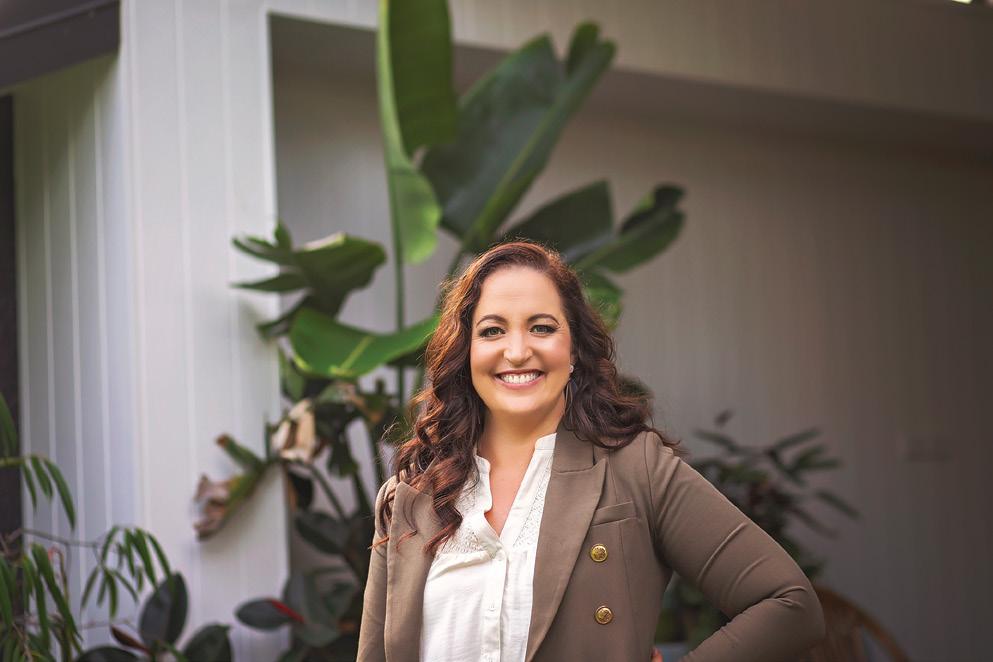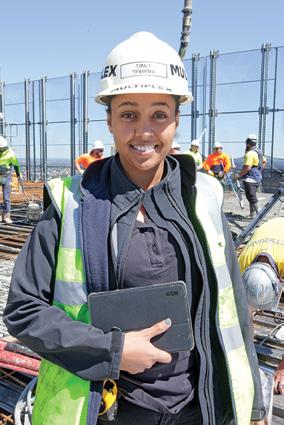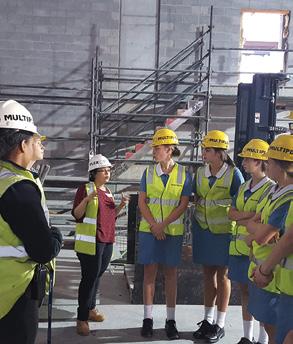
9 minute read
CONSTRUCTION

How you can get involved and help
Advertisement
With an ambitious plan to have the refurbishment and contemporary new green build completed by 2024, Uniting WA is seeking support to help close the funding gap to ensure the reimagined Wyn Carr House becomes a reality.
“As the shortage of affordable housing continues to grow, more women than ever need this critical support. Wyn Carr House has a legacy of nurturing vulnerable women and with your help, we can deliver a solution that enables women in crisis to get the support they need to transition to a secure, stable home,” Lisa Fini, Uniting WA NonExecutive Director and Campaign Chair
$1.5 million is needed from supporters to complete the project, with a further $150,000 needed each year to support residents transitioning to independence. For
individuals, trusts and foundations, this is an opportunity to reach out and support vulnerable women over 55 from your community.
to create pathways that enable people experiencing homelessness to achieve ongoing transformational change.
We know that supported transitional accommodation works as an effective intervention measure, and we are seeking to unite – in a true partnership between a not-for-profit organisation, business, government and philanthropy – to enable and empower vulnerable women to take the first step in their journey to exit homelessness.
Wyn Carr House is a leading example of how private industry can support the community sector in providing vulnerable groups with a modern, safe and respectful space to rebuild their lives. It exemplifies what can be achieved when purposeled private sector organisations partner with the not-forprofit sector to achieve outcomes for the most vulnerable in our community.
HAA is continuing discussions with other property owners in Perth and other cities to create more emergency accommodation, with help from its partners. Changing our approach to housing and homelessness, and funding innovative transitional accommodation projects for women at risk, will also deliver benefits to the State by reducing the financial burden on the Health and Justice systems, as well as the community services sector and delivering lasting social benefits to the broader community. Become one of those in the construction industry who actively support women in our community. Generous (and tax deductible) financial contributions and donations of materials and products to construct, fit out and operate this facility will assist Uniting WA to help vulnerable women to rebuild their lives.
Please visit unitingwa.org.au/wyn-carr-house or housingallaustralians.org.au/whatwedo/give-me-shelter for more information on how you can collaborate with Uniting WA and HAA to contribute to this project.
Pro Bono partners are:
⋅ ⋅ ⋅ ⋅ ⋅ ⋅ ⋅ ⋅ ⋅ ⋅ ⋅ ⋅ ⋅ ⋅ ⋅ ⋅ Cox Architecture RPS (Project management) Planning Solutions (Town planning) Element Heritage (architecture) MinterEllison ARUP Engineers Rider Levett Bucknall (Quantity surveyor) MNG Surveyors Tim Davies Landscaping PrintandSignCo (Printing) Code Group Building (Code compliance) Strategic Fire (Fire engineer) Galt (Geotechnical engineer) Powerledger Sustainable (energy advisory) Braincells (Marketing & Promotional Material) Advance Press (Printing)
HOW CAN WE ENCOURAGE & CREATE MORE PATHWAYS FOR WOMEN ON BOARDS IN CONSTRUCTION?
Research by the 2022 Board Diversity Index suggests that while the number of women on boards increased by 34 (a total of 667) this year, 19% of female directors occupy 48 per cent of female seats.
Recently at a NAWIC lunch for Women on Boards - the question arose:
How do I utilise all my experience and get into a board position?
This fascinating lunch and learn session shared insights around board level positions and how to plan for, position yourself and choose the right board for your career and commitment. There was a clear theme around the room- there is the interest, there is the drive and there is the hunger for board level positions but, where should someone even start?
1. Focus on your potential over performance
One of the first thing to consider is starting to focus on your potential versus performance. It’s about calling out more boldly and clearly and articulating your potential for these positions. It’s about learning to have the conversations and questions we can often be uncomfortable having to position yourself for success and networking. You may not be ready for that board level role yet, but one of the board level members sitting in the chair at this event took her first board level role at 29 years old. So, the idea is to start before you think you are ready and figure out the rest along the way.
2. Develop some core skills valued in boards
There are a few key skills that are often highly valued in a board position so looking at these as part of your career development strategy and pathway are highly regarded for board level roles.
Corporate governance: At a board level you need to be able to articulate and practise good corporate governance. This is a skill that permeates a whole organisation and if you want to change, impact the world and leave it as a better place than this needs to be an underpinning value you hold and can demonstrate competence in for board level roles.
Profit and loss: At a board level you need to really get to know your P&L and become comfortable with the financial responsibility and detail required at a board level. Being accountable and understanding the implications of financial results is a universal skillset that came up as being required to get a seat at a board level position.
There are key skills wanted at boards and a spectrum of competencies and skills. Some of these may include a strategic mindset, technical knowledge and behavioural competencies. You need to be able to identify and articulate your skill capabilities and reflect on what boards you would be looking for. Annual reports and reading through the Chairman’s report and key challenges identified can help you understand where you are against that benchmark and develop a strategy as to how you can position yourself for that board’s particular needs.
3. Select the right board
Once you have identified you want to be a board member, the next step is to select the right board for your unique value proposition and this takes research.
You should assess the effectiveness of the board on decision making and culture development and look very closely at the Chair and their values and corporate governance.

It is the Chair’s responsibility to constructively critique, provide the framework and it is well known that moving from Director to Chair can be three times the increase in responsibility so the person heading up this role is someone you should be looking at very closely.
You need to look at the Chair of the board and ask yourself if they have the right values and look closely at how they steer the ship. The average board level position commitment is 9-10 years so this decision shouldn’t be taken lightly.
4. Volunteer at a school board
Look at the real value you add and match your skill set to the right board. A great way to get exposure is to get board experience at a school. They have complex legal and regulatory frameworks that are a perfect starting point for building your board level career. Schools struggle getting valued members at this level so this is one area you can put your hand up.
5. Don’t go “overboard”
One thing you should avoid when looking at board level position is “overboarding”. Tread slowly, read the papers and ensure you have that day allocated a week for the board commitments so that if something crops up you need to deal with urgently then you have the time allocated with your schedule.
Being a part of the right Board can be a way to leave a legacy and impact in the world which can be truly rewarding when you make the right commitment.
With women holding just 29% of board level positions, there has never been a better time to start planning for change and steer your ship towards a future Chair position.
You’ll never get there if you don’t start somewhere. Lauren Karan
Talent Director at Karan & Co
EMPOWERING GIRLS TO FIND THEIR PLACE IN CONSTRUCTION
One of our industry’s greatest challenges is encouraging more women into construction. In helping to tackle that challenge, Multiplex has enabled its own people to shape a program for schools that has both meaning and impact.
Jump Start is an award-winning mentoring initiative that gives students in Years 9-12 a holistic view of what the construction industry is really like via workshops, panel discussions, site walks, and mentoring sessions.

It was founded in 2019 by a group of Multiplex women working on the One Denison project in North Sydney, who wanted to give female school students a different experience to their own.
“As school students, we weren’t given an opportunity to learn about the different career options within the built environment, and we had to rely on trial and error to find what was right for us,” said Jump Start co-founder and Multiplex Project Engineer Timnit Tessema.
“We drew on that experience to develop the kind of program we wished we had as students.”
Jump Start was piloted with students from local schools invited to the One Denison project site, to see first-hand what a day in the lift of delivering a project is really like.
“The industry is clouded by many stigmas that deter young women from entering this field. We wanted to help change the way girls perceive construction and break down some of the stereotypes,” said Timnit.
“We also wanted to show them what’s possible and excite them about the prospect of a career in construction. It’s such a rewarding career choice with so many different people coming together to deliver a project.
“With Jump Start, girls can see for themselves that the construction industry is broader, better, and more diverse than they think.” A key point of difference from any other program in the industry, is that Jump Start works not just with students, but also their extended communities.

“We not only educate these young women, but we also aim to educate their educators, career advisors, and parents to ensure accurate information is being distributed,” said Timnit.
By breaking down stereotypes and providing a more accurate look at the industry, Jump Start helps foster not only the students’ natural interest in construction and but helps provide guidance for their support networks to empower them to pursue it if they choose.
From on-site pilot to national expansion
Following a successful pilot and collaboration with schools to fine-tune the syllabus, Jump Start has been embraced by Multiplex and become an important part of its overall Diversity and Inclusion commitment.
Multiplex now rolls out Jump Start across projects in Queensland, Western Australia, and the Australian Capital Territory. It is also proudly run on every project in New South Wales.
“We know from research that to attract more women into construction, we need to educate them early at the point at which they are beginning to consider their future careers,” said Executive Director of People at Multiplex Caitriona Comerford.
“Jump Start is allowing us to do that in a very grass roots way. It works because it is grounded in our people and their experiences; the same group of women that started it continue to be instrumental in its expansion.”
Reflecting on the success of Jump Start, Timnit says it’s the impact it has on students that is the most rewarding.
“I have seen students who were in our pilot program in 2019 now start to enter the construction workforce – I am most proud of that. I am proud that change is happening, and I can assist with that.”










